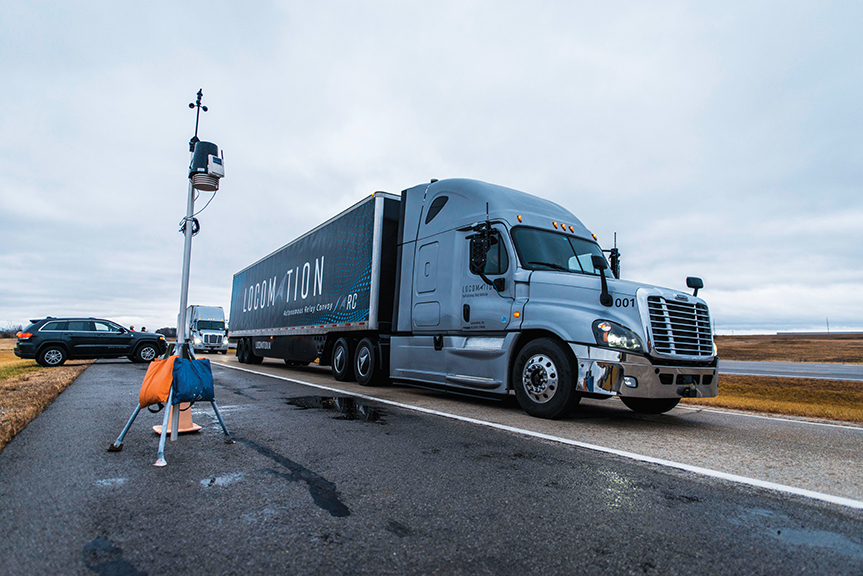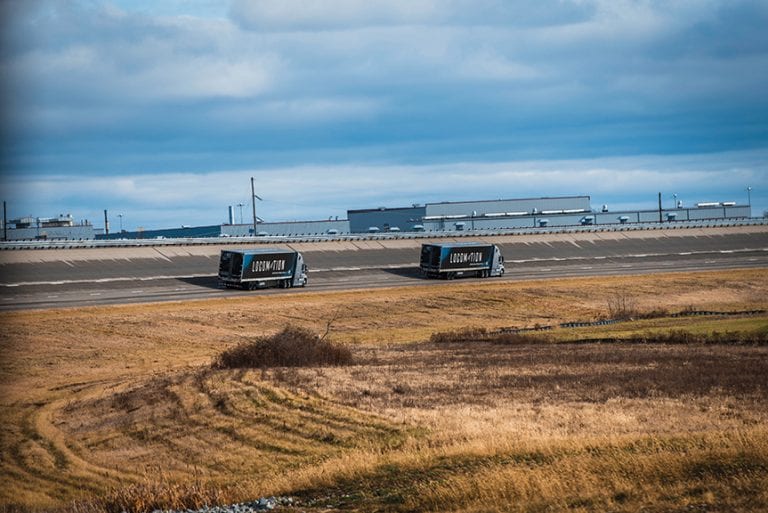The term “platooning” has mostly faded from trucking media, but it’s a huge part of the march to total autonomy at Pittsburgh-based Locomation. According to Chief Commercial Officer Glynn Spangenberg, the team at Locomation believes that platooning is the fastest way to develop the artificial intelligence needed to eventually replace human drivers.
“They (Locomation engineers) determined that ‘human-guided autonomy,’ that’s one of our mottos, was the best approach,” shared Spangenberg. “With a human driver in control of the first truck, the second truck goes through a progression of learning how to be an autonomous truck.”
“Learning” is a solid description of where autonomous trucks are today, or, at least, the status of the artificial intelligence that drives them. That’s an important distinction, according to a January 6 blog post from Waymo, that said the company will no longer use the term “self-driving” in discussing its technology, replacing it with the term “fully autonomous.”
While the difference may seem small, it underscores that something is in control of the vehicle, making decisions and guiding its actions. At Locomation, the human driving the first truck in a platoon is also a teacher.
“Each time the truck goes out under the control of a driver, the computer records all of the usual sensor data and predicts how the computer would have reacted to each situation,” explained Spangenberg.
The practice allows engineers to better understand where the artificial intelligence differs from the human driver. “If the driver does something different than predicted by the computer, an engineer analyzes why that happened and makes necessary changes to the programming,” he continued. “In this way, the truck learns from the human driver and will eventually be self-sufficient.”
That’s when Truck No. 2 becomes a “drone follower,” without a driver at all, according to Locomation’s website. The step after that will be trucks without drivers, first traveling from hub to hub and eventually dock to dock, steps that will occur when the systems have “learned” enough.
Learning extends beyond the technology companies currently working on autonomous technology. Auburn University has conducted platooning trials on its 1.7-mile test track and on I-85 and U.S. 280 in Alabama. “We’re not only helping advance the technology, but we’re developing future engineers to work in the field,” said Department of Mechanical Engineering Professor David Bevly. “OEMs and developers of autonomous technology have hired our graduates.”
Auburn recently unveiled its new autonomous vehicle research facility at the track, announcing that it will aid researchers in the school’s GPS and Vehicle Dynamics Laboratory, or GAVLAB. Bevly’s group consists of 40 researchers, mostly grad students.
While the names Auburn University and GAVLAB may not be familiar in the autonomous trucking field, the technology they help develop could end up in anyone’s product. “Since our research typically involves algorithms and software, it won’t be highly visible to your readers but could already be a part of many of the autonomous programs currently working,” explained Bevly. “Our results are published by the Society of Automotive Engineers (SAE) and are available to builders and vendors who subscribe.”
The question on the minds of many trucking industry leaders is, “When will the technology be ready to add to our fleet?” In September 2020, Locomation announced what it claims is the world’s first autonomous truck purchase order, for 1,120 tractors equipped with the Locomation autonomy system sold to Springfield, Missouri-based Wilson Logistics.
“We’re looking at the second half of 2022 for the first Wilson trucks to be ‘upfitted’ with the Locomation technology and begin being placed into operation,” shared Spangenberg. The company has entered an agreement with Rush Enterprises to fit new tractors with its autonomous technology.
“New trucks will go directly from the assembly line to Rush Enterprises, where they will be upfitted with the Locomation system before being placed into service at Wilson,” he said.

Locomation’s ARC technology is more than platooning software. The program identifies lanes within the carrier’s customer base where the technology could be used, helping truck drivers to maximize efficiency. “Many carriers find that 35% to 50% of their current load portfolio is suitable for the ARC platform,” noted Spangenberg.
Potential savings are considerable. “We estimate that for a 500-mile length of haul that might normally cost the carrier $1.71 per mile, our model, including initial investment costs, brings that down to $1.46 per mile,” he added. That 14.6% reduction in cost could be attractive in an industry with razor-thin profit margins.
Currently, an investment in ARC technology includes installation of the equipment, training for drivers and a 36-month subscription to the ARC platform.
The platform could be offered to shippers, too, who might then group loads by suitability for platooning with the expectation of benefitting from the reduced cost. It’s even conceivable that trucks from different carriers could platoon together, if the carriers were willing to share ARC information.
A potential drawback to autonomous technology is driver acceptance, but Spangenberg thinks it’s a matter of attitude. “Instead of looking at jobs that could be lost, look at the opportunities for drivers who can work within the system,” he said. “(Ask yourself) ‘Where can I benefit?’” Technology could help alleviate the current driver shortage before drivers are replaced.
The next big hurdle for autonomy is the regulatory landscape. “States are taking a lead role in determining what they want to do,” added Spangenberg. “The problem is that some states want one thing while other states want something else. The federal government, through both legislation and regulation, will need to implement a national strategy.”
Still, carriers will be limited in using the technology until nationwide standards are adopted. One legislative concern is labor-friendly states that might ban the technology over job-loss worries. “There need to be federal laws that prevent states from adopting technology based on labor concerns,” he insisted.
Federal Motor Carrier Safety Administration Deputy Administrator Meera Joshi addressed the topic at the agency’s 20th annual Analysis, Research and Technology forum, held online March 10, 2021. “It is certainly a priority of this administration, this DOT [to cooperate] with the Department of Labor to understand the extremely real and broad impacts of automation on people’s livelihoods,” she said.
She raised concerns, however, by predicting “a major shift in the workforce” would occur due to technology.
While the artificial intelligence that will one day drive trucks is still learning, the industry is hopeful that the leadership that makes the rules is learning, too.
Cliff Abbott is an experienced commercial vehicle driver and owner-operator who still holds a CDL in his home state of Alabama. In nearly 40 years in trucking, he’s been an instructor and trainer and has managed safety and recruiting operations for several carriers. Having never lost his love of the road, Cliff has written a book and hundreds of songs and has been writing for The Trucker for more than a decade.















